To guarantee top-quality homemade herbal tea blends, start by sourcing fresh, organic herbs from reputable suppliers or growing your own. Store herbs properly in airtight, light-blocking containers to maintain potency. Balance flavors by combining complementary herbs, using precise measurements for consistency. Choose food-safe packaging materials and label blends clearly with ingredients and dates. Regularly test your creations for quality and taste, adjusting as needed. Be aware of potential allergens and include this information on labels. Optimize brewing instructions for each blend, considering steeping times and water temperatures. By following these essential tips, you'll be well on your way to crafting exceptional herbal teas. The journey to perfecting your blends is just beginning.
Sourcing High-Quality Herbs
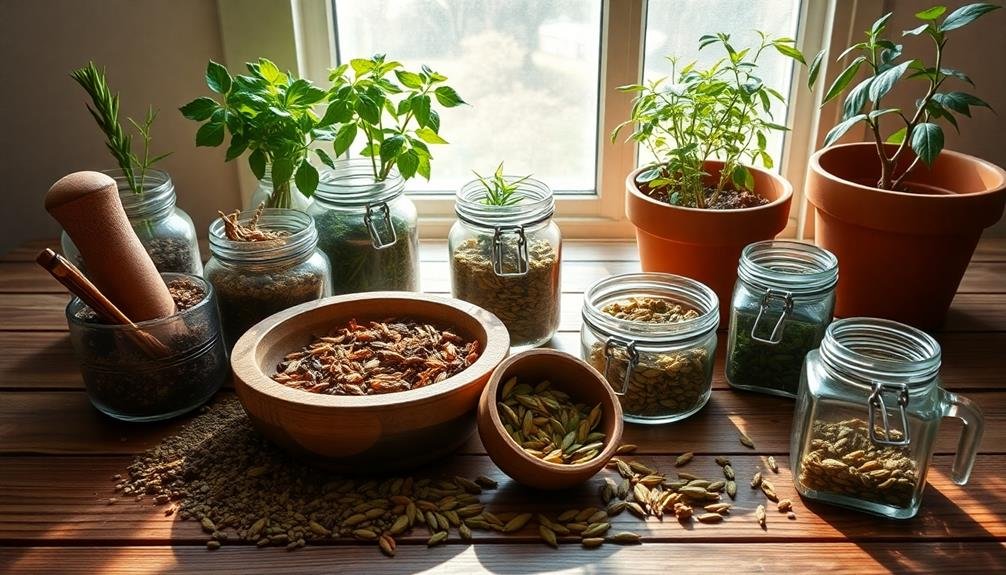
The foundation of any great herbal tea blend lies in the quality of its ingredients. To source high-quality herbs, start by researching reputable suppliers. Look for companies that specialize in organic, sustainably grown herbs and offer detailed information about their sourcing practices.
When purchasing herbs, opt for whole leaves or flowers rather than pre-ground options. This allows you to assess the quality visually and guarantees maximum freshness. Pay attention to the herbs' appearance, aroma, and texture. Fresh herbs should have vibrant colors, strong scents, and crisp textures.
Consider growing your own herbs if you have the space and time. This gives you complete control over the growing process and guarantees the freshest possible ingredients. If you can't grow your own, visit local farmers' markets or herb farms to find high-quality, locally sourced options.
Store your herbs properly to maintain their quality. Keep them in airtight containers away from light, heat, and moisture. Label each container with the herb's name and purchase date to track freshness.
Proper Storage Techniques
With proper storage, your carefully sourced herbs will maintain their flavor, aroma, and medicinal properties for months. To preserve their quality, keep your herbs in airtight containers away from light, heat, and moisture. Glass jars with tight-fitting lids or opaque ceramic containers work well. Store these in a cool, dark place like a pantry or cupboard.
Label each container with the herb's name and purchase date. This helps you track freshness and rotate your stock. Most dried herbs retain their potency for about six months to a year when stored correctly.
Here's a quick guide to ideal storage conditions for different herb types:
| Herb Type | Container | Storage Location |
|---|---|---|
| Dried Leaves | Airtight Glass Jar | Cool, Dark Pantry |
| Roots/Barks | Ceramic Container | Dry Cupboard |
| Flowers | Opaque Tin | Refrigerator |
For long-term storage, you can freeze herbs. Place them in airtight freezer bags, removing as much air as possible. Frozen herbs can last up to a year without significant loss of quality. Remember, proper storage isn't just about longevity—it's about preserving the full potential of your herbal tea ingredients.
Balancing Flavor Profiles
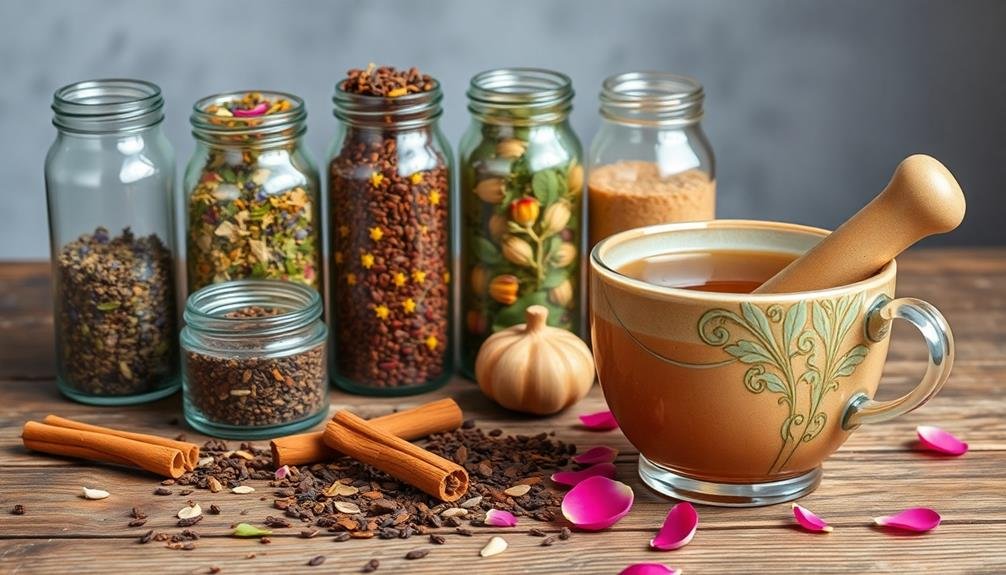
Creating a well-balanced herbal tea blend is both an art and a science. You'll need to take into account the flavors, aromas, and strengths of each herb to achieve a harmonious combination.
Start by identifying your base herb, which will form the foundation of your blend. Then, add complementary herbs to enhance the overall flavor profile.
When balancing flavors, take into account these key elements:
- Sweetness: Herbs like licorice root or stevia can add natural sweetness.
- Bitterness: Dandelion or chamomile can provide a subtle bitter note.
- Spiciness: Ginger or cinnamon can add warmth and depth.
Experiment with different ratios to find the perfect balance. A general rule of thumb is to use 60% base herbs, 30% supportive herbs, and 10% accent herbs.
Don't be afraid to adjust these percentages based on your personal preferences.
Remember to taste your blend at different steeping times to make certain the flavors develop properly. If one herb overpowers the others, reduce its quantity or steep time.
Keep notes on your blends and iterations to refine your recipes over time. With practice, you'll develop an intuitive sense for creating well-balanced, delicious herbal tea blends.
Measuring and Portioning Ingredients
Accurately measuring and portioning ingredients is essential for consistent, reproducible herbal tea blends. You'll need to invest in precise measuring tools like digital scales, measuring spoons, and graduated cylinders. For small quantities, use a scale that measures in grams or tenths of grams. For larger batches, a scale with a higher capacity will suffice.
When measuring dried herbs, use weight rather than volume whenever possible. This guarantees accuracy, as different herbs have varying densities. If you must use volume measurements, be consistent in how you fill your measuring spoons – level them off for reproducible results.
Create a standardized recipe card for each blend, listing ingredients by weight or precise volume measurements. This allows you to scale your recipes up or down easily.
When portioning your blends, consider using tea bags or fillable tea filters for convenience. If you're creating loose tea blends, store them in airtight containers and include a recommended serving size on the label.
Remember to adjust your measurements based on the potency of your herbs. Stronger herbs may require smaller quantities, while milder ones might need larger portions to achieve the desired flavor profile.
Choosing Appropriate Packaging Materials
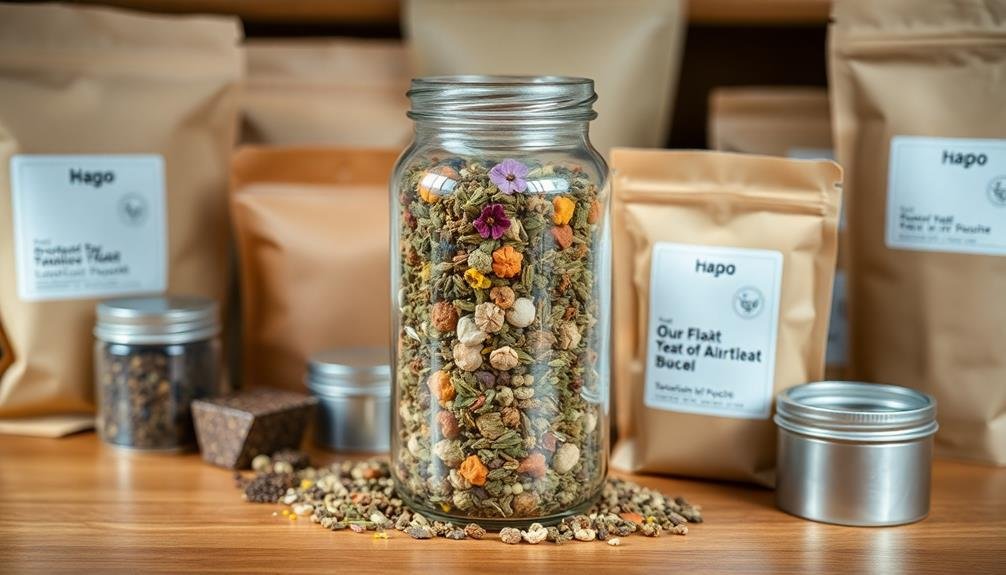
When packaging your homemade herbal tea blends, you'll want to prioritize freshness and quality preservation.
Choose airtight containers to lock in flavors and prevent moisture from spoiling your mix.
Opt for light-blocking storage options like opaque tins or dark glass jars, and guarantee all packaging materials are food-safe to maintain the purity of your herbal creations.
Airtight Containers for Freshness
Preservation is key when it comes to storing your homemade herbal tea blends. Airtight containers are your best allies in maintaining the freshness, flavor, and aroma of your carefully crafted teas.
When choosing containers, opt for those made of materials that won't impart any unwanted flavors or odors to your blends. Glass jars with tight-fitting lids are an excellent choice, as they're non-reactive and allow you to see the contents easily. Alternatively, you can use food-grade stainless steel containers, which are durable and protect against light exposure. If you prefer plastic, make certain it's BPA-free and food-safe.
To maximize the longevity of your herbal tea blends, follow these tips:
- Store containers in a cool, dry place away from direct sunlight
- Label each container with the blend name and date of preparation
- Use smaller containers for frequently used blends to minimize air exposure
Light-Blocking Storage Options
While airtight containers protect your herbal tea blends from moisture and air, they don't always shield them from light. Light exposure can degrade the quality of your herbs, causing them to lose flavor, aroma, and beneficial properties. To preserve your blends' potency, you'll need to take into account light-blocking storage options.
Opaque containers are your best bet for keeping light at bay. Choose materials like ceramic, stainless steel, or dark-colored glass. If you prefer clear containers for easy identification, opt for amber or cobalt blue glass, which filter out harmful UV rays. You can also use light-blocking bags made of kraft paper or metalized materials.
Here's a comparison of different light-blocking storage options:
| Material | Light Protection | Durability | Cost |
|---|---|---|---|
| Ceramic | Excellent | High | High |
| Stainless Steel | Excellent | High | Medium |
| Dark Glass | Very Good | Medium | Medium |
| Amber Glass | Good | Medium | Low |
| Kraft Paper | Good | Low | Low |
When storing your herbal tea blends, place them in a cool, dark area like a pantry or cupboard. If you must display them, use UV-resistant sleeves or covers to provide an extra layer of protection. By choosing the right light-blocking storage options, you'll make certain your homemade herbal tea blends maintain their quality and potency for longer periods.
Food-Safe Packaging Materials
Considering the importance of food safety, it's crucial to choose appropriate packaging materials for your homemade herbal tea blends. When selecting packaging, opt for food-grade materials that won't leach harmful chemicals or alter the taste of your teas.
Glass jars with airtight lids are an excellent choice, as they're inert and won't react with your blends. You can also use food-safe, BPA-free plastic containers, but be aware that they may retain odors over time.
For individual tea servings, consider using unbleached paper tea bags or reusable cotton muslin bags. These options allow your tea to steep properly while keeping the loose herbs contained.
If you're planning to gift your blends, you might want to explore eco-friendly packaging options like biodegradable cellophane bags or recycled paper boxes.
When packaging your herbal tea blends, remember to:
- Clean and sanitize all containers before use
- Verify packaging is completely dry to prevent mold growth
- Label each blend with ingredients and preparation instructions
Sterilizing Equipment and Containers
When making your own herbal tea blends, proper sterilization of equipment and containers is essential for safety and quality.
You'll need to thoroughly clean all utensils, jars, and storage containers using hot, soapy water before rinsing them well.
After cleaning, you should consider using boiling water or a diluted bleach solution to sanitize your equipment, ensuring it's completely dry before use.
Proper Cleaning Methods
Three essential steps guarantee your homemade herbal tea blends remain safe and free from contaminants.
First, always wash your hands thoroughly with soap and warm water before handling any equipment or ingredients. This simple act prevents the transfer of bacteria and other harmful microorganisms to your tea-making supplies.
Next, clean all your equipment and containers using hot, soapy water. Scrub each item carefully, paying special attention to crevices and hard-to-reach areas where residue can accumulate. Rinse everything thoroughly with clean, hot water to remove all soap traces.
Finally, dry your equipment and containers completely before use. Air drying is often the best method, but if you're short on time, use a clean, lint-free cloth. Moisture can harbor bacteria, so make sure everything is bone-dry before storing or using it.
For an extra layer of protection, consider these additional cleaning methods:
- Use a vinegar solution (1 part vinegar to 3 parts water) to naturally disinfect equipment
- Sanitize glass and metal items in boiling water for 5 minutes
- Run dishwasher-safe items through a high-temperature cycle for thorough cleaning
Storage and Handling
Proper cleaning sets the stage for effective sterilization of your tea-making equipment and containers. After washing, you'll need to sterilize everything to guarantee your herbal blends remain free from harmful bacteria and mold.
To sterilize glass jars and metal utensils, submerge them in boiling water for at least 10 minutes. For plastic containers, use a food-safe sanitizing solution. Once sterilized, allow everything to air dry completely before use.
When handling your herbs and tea blends, always use clean, dry hands or utensils. Store your herbal ingredients in airtight containers away from direct sunlight, heat, and moisture. Glass jars or food-grade plastic containers work well for this purpose.
Keep your tea blends in a cool, dark place to preserve their flavors and beneficial properties. If you're using fresh herbs, store them in the refrigerator and use them within a few days. Dried herbs can last several months when stored properly.
Label your containers with the blend name and date of preparation. This practice helps you track freshness and rotate your stock.
Labeling and Dating Blends
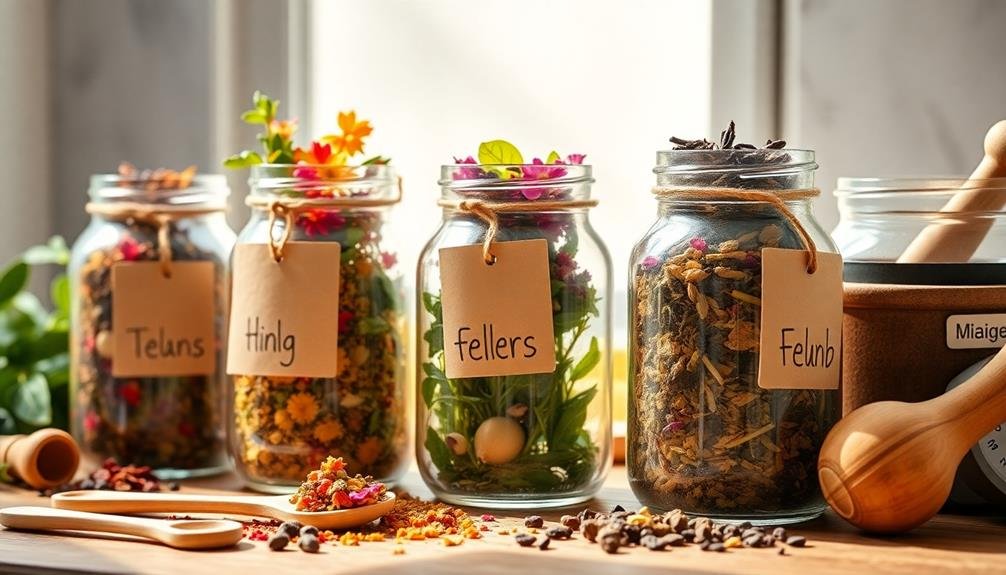
Blend identification is vital when creating your own herbal tea mixtures. You'll want to label your blends clearly to avoid confusion and guarantee you're using the right combination each time. Use waterproof labels or permanent markers to write the blend's name and ingredients on the container.
It's also essential to include the date you created the blend, as this helps you track freshness and potency.
When labeling your herbal tea blends, consider including the following information:
- Blend name and primary ingredients
- Date of creation or packaging
- Recommended brewing instructions (water temperature, steeping time)
By providing these details, you'll have a quick reference for each blend's characteristics and ideal preparation method. This practice is especially helpful if you're creating multiple blends or sharing your teas with others.
Don't forget to update your labels if you make any changes to the blend's composition. Regularly review your tea inventory and discard any blends that have exceeded their recommended shelf life.
Testing for Consistency
To guarantee your herbal tea blends consistently deliver the desired flavor and aroma, you'll need to test them regularly. Start by brewing a small sample of your blend and evaluating its taste, smell, and appearance.
Take notes on these characteristics and compare them to your original recipe or previous batches. If you notice any discrepancies, adjust your blend accordingly. You might need to tweak the ratios of ingredients or replace older herbs with fresher ones.
It's also important to test your blends over time to ascertain they maintain their quality during storage. Consider conducting blind taste tests with friends or family members to get unbiased feedback. This can help you identify any subtle changes in flavor that you might've missed.
Additionally, try brewing your tea using different water temperatures and steeping times to find the best preparation method for each blend.
Don't forget to test for consistency across different batches. If you're making larger quantities, sample from various parts of the mixture to guarantee even distribution of ingredients.
Identifying Potential Allergens
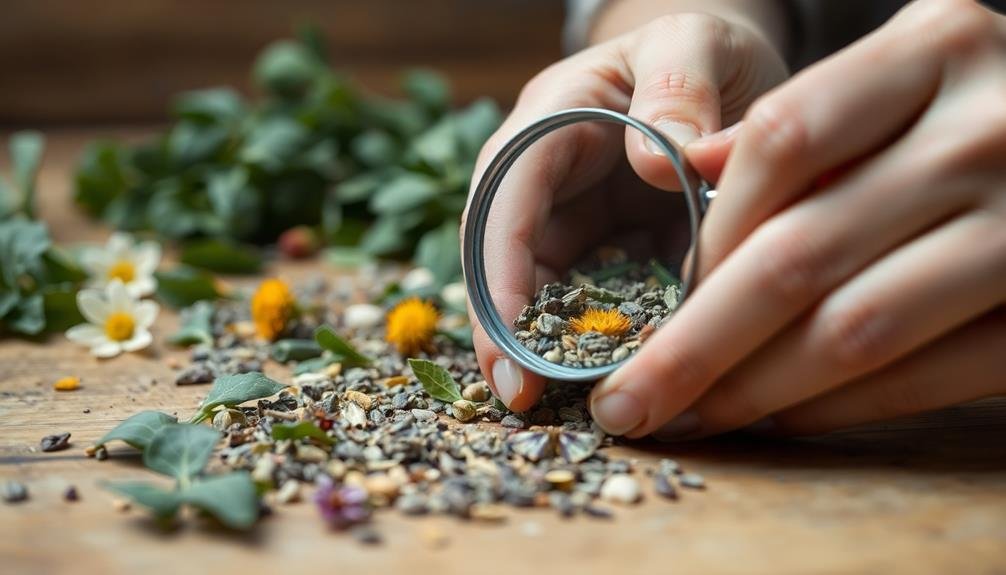
When creating your own herbal tea blends, it's essential to be aware of common allergens like chamomile, ginger, and licorice root.
You'll need to take into account cross-reactivity risks, as some herbs may trigger allergies in people sensitive to related plants.
Always label your homemade blends with a complete list of ingredients to guarantee safety for yourself and others who might enjoy your teas.
Common Tea Allergens
Despite the soothing nature of herbal teas, it's crucial to be aware of potential allergens lurking in your cup. Common tea allergens can cause unexpected reactions, ranging from mild discomfort to severe health issues. Be particularly cautious if you have known allergies or sensitivities to plants, as many herbal teas contain components from various botanical families.
Some of the most common tea allergens include:
- Chamomile: Part of the ragweed family, it can trigger reactions in those with pollen allergies.
- Licorice root: May cause adverse effects in people with high blood pressure or heart conditions.
- Echinacea: Can cause allergic reactions in individuals sensitive to plants in the daisy family.
When creating your herbal tea blends, always research the ingredients thoroughly. If you're unsure about potential allergies, start with small amounts and monitor your body's response.
It's also wise to keep a log of the teas you drink and any reactions you experience. This practice will help you identify problematic ingredients and adjust your blends accordingly.
Cross-Reactivity Risks
Cross-reactivity in herbal teas often catches tea enthusiasts off guard. When you're blending your own herbal teas, it's vital to understand that certain herbs can trigger allergic reactions similar to those caused by seemingly unrelated plants. This phenomenon occurs due to shared proteins or compounds between different plant species.
If you're allergic to ragweed, you might react to chamomile or echinacea. Birch pollen allergies can lead to reactions with fennel or anise. Those with latex allergies should be cautious with dandelion root. It's important to research each herb's potential cross-reactivity before including it in your blend.
To minimize risks, start by identifying your known allergies and any related plant families. Introduce new herbs one at a time, in small amounts, to monitor for reactions. Keep a detailed log of your blends and any symptoms you experience.
If you're particularly sensitive, consider consulting an allergist before experimenting with new herbs. Remember, even common herbs like mint or ginger can cause unexpected reactions in some individuals. By staying informed and cautious, you'll create safer, more enjoyable herbal tea blends tailored to your needs.
Labeling for Safety
After blending your perfect herbal tea mixture, proper labeling becomes vital for safety. Identifying potential allergens in your homemade blend is essential to protect yourself and others who might consume your tea. Always list all ingredients clearly on the label, even if you think they're common or harmless. Some herbs can trigger allergic reactions in sensitive individuals, so it's better to err on the side of caution.
When labeling your herbal tea blends, consider these key points:
- Use clear, legible writing or printing to make certain all ingredients are easily readable.
- List ingredients in order of quantity, starting with the most abundant herb.
- Highlight any known allergens or potential cross-reactants in bold or with an asterisk.
Don't forget to include the date of blending and any recommended storage instructions. If you're giving your tea as a gift or selling it, add a brief description of the blend's flavor profile and intended benefits.
Optimizing Brewing Instructions
To get the most out of your homemade herbal tea blends, you'll need to master the art of brewing. Start by using the right water temperature. For most herbal teas, boiling water (212°F/100°C) is ideal, but some delicate herbs may require slightly cooler water to prevent bitterness.
Next, consider the steeping time. Generally, herbal teas need 5-7 minutes to release their full flavor and benefits. However, this can vary depending on the herbs used. Roots and barks may require longer steeping, while flowers and leaves often need less time.
Pay attention to the herb-to-water ratio. A good rule of thumb is 1-2 teaspoons of dried herbs per cup of water. For fresh herbs, double this amount. Adjust based on personal preference and the strength of your blend.
Use the right brewing vessel. Loose leaf infusers, tea balls, or reusable tea bags work well for most blends. For larger batches, consider using a French press or teapot with a built-in strainer.
Quality Control Checks
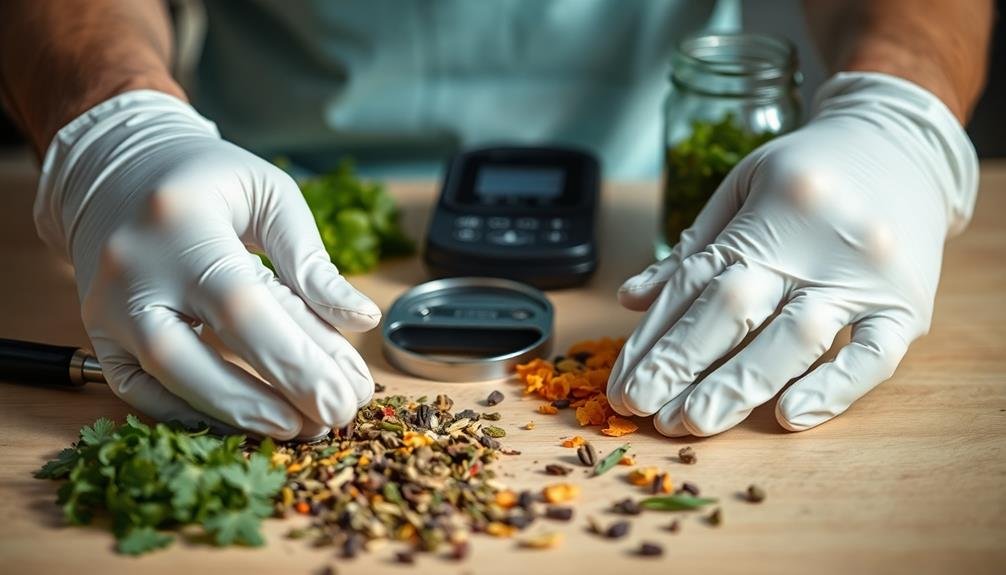
Once you've mastered the brewing process, it's important to implement quality control checks for your homemade herbal tea blends. These checks guarantee consistency, safety, and peak flavor in every cup.
Start by examining your dried herbs regularly for signs of mold, discoloration, or unusual odors. If you spot any issues, discard the affected herbs immediately to prevent contamination.
Next, focus on proper storage. Keep your herbs in airtight containers away from light, heat, and moisture. This preserves their potency and prevents degradation.
Regularly rotate your stock, using older herbs first to maintain freshness.
Finally, conduct taste tests periodically to verify your blends maintain their intended flavor profiles. Here's a simple process:
- Brew a small batch of each blend
- Compare the aroma and taste to your original recipe notes
- Adjust the ratios or ingredients if necessary
Frequently Asked Questions
Can I Use Fresh Herbs Instead of Dried Ones in My Tea Blends?
Yes, you can use fresh herbs in your tea blends. They'll provide a more vibrant flavor, but you'll need to use more of them compared to dried herbs. Be sure to wash them thoroughly before steeping.
How Long Do Homemade Herbal Tea Blends Typically Stay Fresh?
Your homemade herbal tea blends can stay fresh for 6-12 months when stored properly. Keep them in airtight containers away from light, heat, and moisture. You'll notice a decline in flavor and aroma when they're past their prime.
Are There Any Herbs That Should Never Be Mixed Together?
You should avoid mixing certain herbs together. Don't combine St. John's Wort with antidepressants, or licorice root with blood pressure medications. It's best to consult an herbalist or your doctor before mixing herbs, especially if you're on medication.
What's the Best Way to Grind Herbs for Tea Blends?
You'll get the best results using a mortar and pestle for small batches. For larger quantities, try a coffee grinder or spice mill. Don't over-grind; you want small pieces, not powder, for ideal flavor release.
Can I Add Essential Oils to Enhance the Flavor of My Tea Blends?
You shouldn't add essential oils to tea blends. They're not safe for internal use and can be harmful if ingested. Instead, use dried herbs or natural extracts specifically made for culinary purposes to enhance your tea's flavor.
In Summary
You've now got the essential tips for creating top-quality homemade herbal tea blends. Remember to source the best herbs, store them properly, and balance flavors carefully. Don't forget to measure accurately, choose the right packaging, and test for consistency. Always identify potential allergens and optimize your brewing instructions. Finally, implement regular quality control checks. With these steps, you'll be crafting exceptional herbal teas that'll delight your taste buds and those of your lucky recipients.


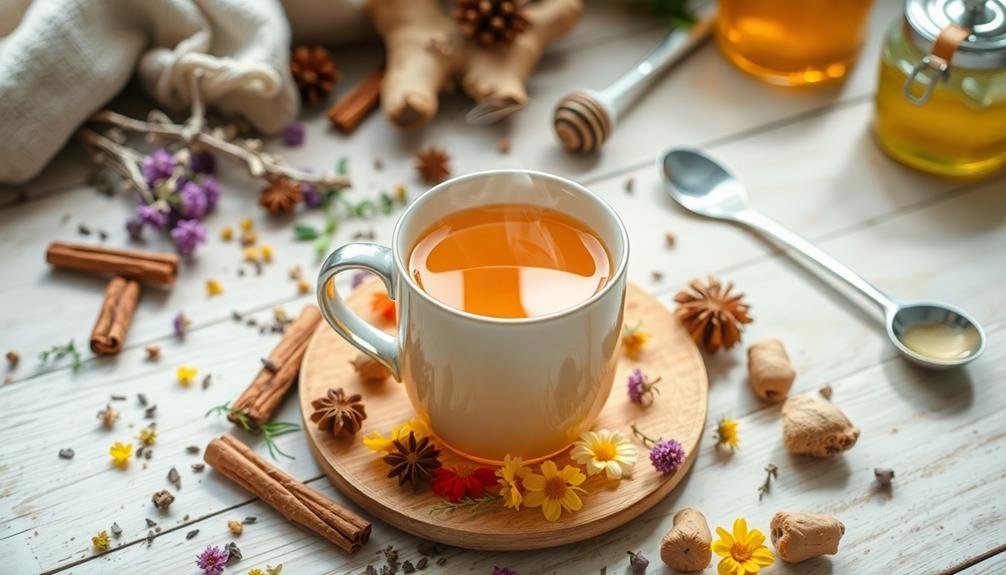
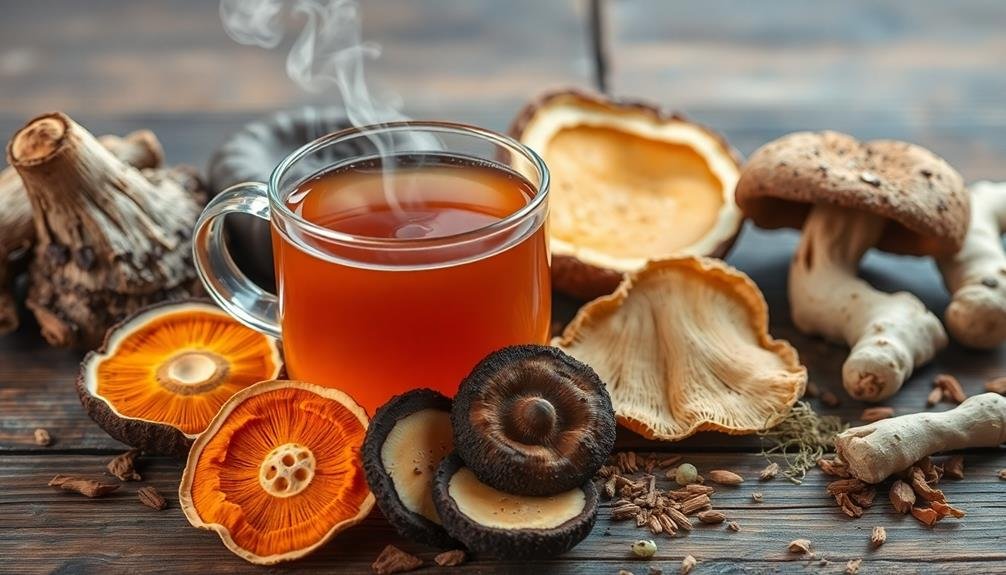
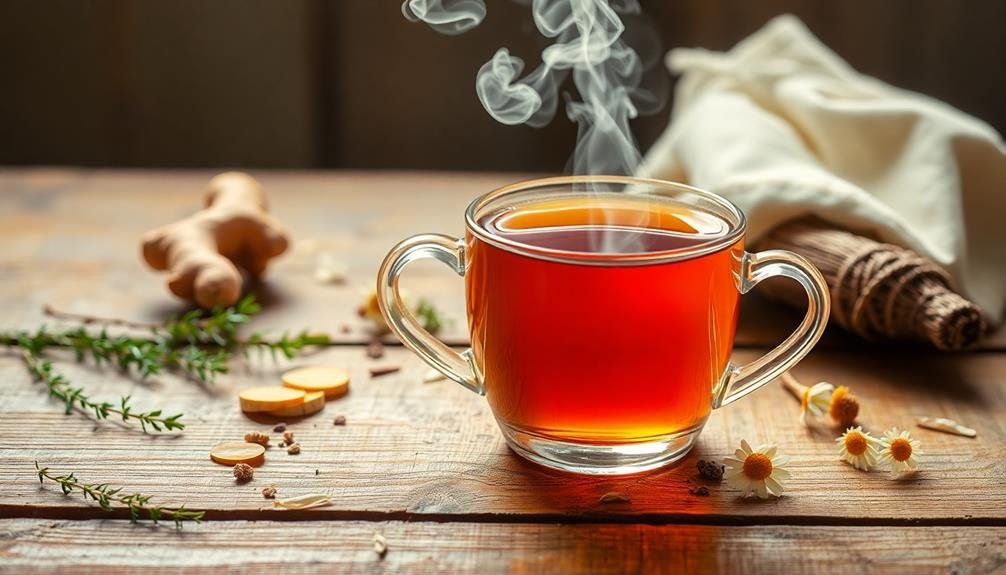
Leave a Reply